Volcanic Twilight Diary
Volcanic Twilight Diary: Unveiling the Spectacular Colors of the Sky
Have you ever marveled at the breathtaking beauty of a twilight sky? The interplay of colors as the sun sets can create a mesmerizing spectacle that captivates our senses. However, there are certain occurrences that make twilights even more extraordinary. One such phenomenon is the presence of volcanic ash and aerosols in the stratosphere, which can give rise to vivid and richly colored twilights, including the elusive purple light. In this article, we will delve into the fascinating world of volcanic twilights and explore the remarkable effects they produce.
The Influence of Volcanic Eruptions on Twilights
Historically, volcanic eruptions have been known to influence the colors of twilights. The eruption of Krakatoa in 1883, for instance, resulted in vibrant and even lurid sunsets that were observed worldwide. The iconic painting "The Scream" by Edvard Munch, created in 1893, possibly depicts a realistic portrayal of the sky during that time. More recently, the 2008 eruption of Kasatochi produced spectacular twilight effects. However, it's important to note that volcanoes are not always responsible for these captivating displays. Twilights can exhibit a range of fascinating phenomena, such as twilight arches, stratospheric rays and shadows, and even the elusive purple light, at various times.
Capturing the Colors: Techniques for Observing Volcanic Twilights
To witness the full spectrum of colors during a volcanic twilight, it is recommended not to fixate solely on the sunset sky. Instead, try this technique: Turn away from the sunset and direct your gaze towards a dark area for about 30 seconds. Then, swiftly turn your attention back to the twilight sky. You might be astounded by the array of colors that await you. This method allows your eyes to adjust and perceive the nuances of the twilight hues more effectively.
Exploring the Twilights: A Diary of Colors
Let's embark on a journey through a vivid diary of volcanic twilights. Each entry reveals a unique aspect of these awe-inspiring phenomena:
-
February 15: After sunset, the western sky glows with a band of strongly yellow-straw colors, creating what is known as the "twilight arch." This phenomenon occurs when sunlight, reddened by its long path through the atmosphere, illuminates the stratosphere. Dust and aerosols then scatter the rays downward, creating a magnificent display.
-
Jagged 'Clouds': The jagged formations observed during volcanic twilights are believed to be stratospheric clouds. These intricate structures add an element of complexity and intrigue to the already captivating scene.
-
The View from Above: A glimpse into Earth's atmosphere from an altitude of 10-12km over the Atlantic reveals a reddened dust layer above the troposphere. This layer showcases the presence of aerosols and their role in scattering sunlight, contributing to the colorful phenomenon of volcanic twilights.
-
Ejecta from June's Volcanoes: The aftermath of June's volcanic eruptions is still visible in the northern hemisphere. Long shadow streaks and rays emanate from the dust clouds, accompanied by a strong twilight arch. Above it all, the deep glow of the elusive purple light adds an ethereal touch to the spectacle.
-
Unveiling the Purple Light: The formation of the purple light during volcanic twilights is a result of high-altitude rays passing through rarified air that is not reddened. Ozone further enhances this effect, rendering the rays bluish. Aerosols play a crucial role by scattering both types of rays to our eyes, creating a mixture that appears purple.
-
Finely Structured Straky Clouds: During volcanic sunsets, keep an eye out for finely structured straky clouds. By using binoculars and carefully distinguishing them from lower clouds, you can appreciate the intricate details and patterns they form in the sky.
-
Raikoke's Influence: The eruption of Raikoke sends dust and sulfur dioxide high into the stratosphere. Subsequently, the gaseous sulfur dioxide reacts with water vapor to form tiny aerosol droplets of sulfuric and sulfurous acids. These droplets are only about 1 micron in diameter but scatter sunlight more effectively than dust, intensifying the visual impact of volcanic twilights.
-
A September to Remember: The captivating effects of volcano eruptions continue to color the twilight well into September. The prolonged presence of volcanic particles in the atmosphere ensures that the enchanting display persists, captivating observers for an extended period.
As we conclude our exploration of volcanic twilights, we invite you to observe and appreciate the beauty of these natural phenomena whenever the opportunity arises. Whether it be the remarkable colors of a twilight arch, the intricate patterns of stratospheric clouds, or the elusive purple light, each experience offers a glimpse into the fascinating interplay between light and atmospheric particles.
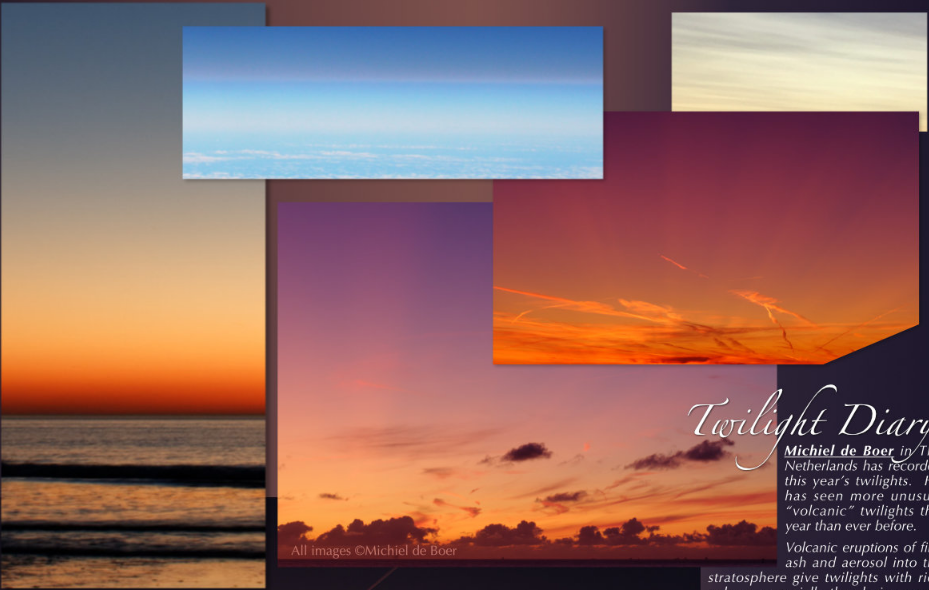
Twilight Diary
Michiel de Boer in The Netherlands has recorded this year's twilights. He has seen more unusual "volcanic" twilights this year than ever before.
Volcanic eruptions of fine ash and aerosol into the stratosphere give twilights with rich colours, especially the elusive purple light. Krakatoa in 1883 was famously responsible for colourful even lurid sunsets worldwide. The sky in Munch's 1893 The Scream is possibly
a realistic portrayal.
Rather more recently the 2008 eruption of Kasatochi produced spectacular twilight effects (12). This year's June eruptions of Raikoke and Ulawun are still giving us enhanced twilights.
But volcanoes are not always responsible or even needed. Check twilights regularly to see twilight arches, stratospheric rays and shadows and even the elusive purple light at other times.
A technique for catching these colour effects, especially the purple light is not to stare towards the sunset sky. Turn away for 30 seconds or so and look somewhere dark. Then turn quickly towards the twilight - you could be amazed!
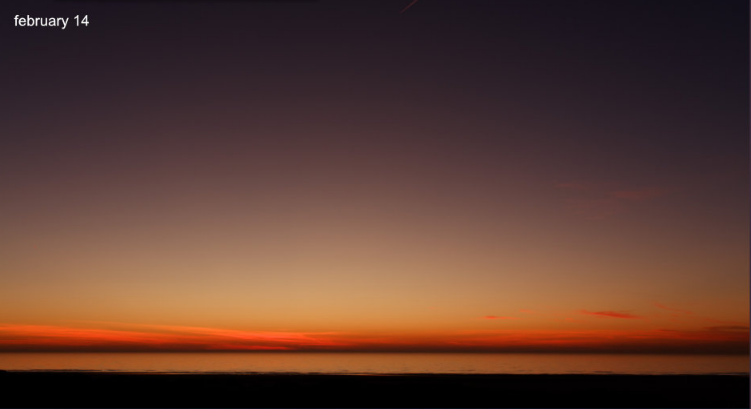

february 15
After sunset the western sky glows with a band of strongly yellow-straw colours.
This is the "twilight arch". The stratosphere is still lit by sunlight that has been reddened by its long path through the atmosphere. The rays are scattered downwards to the eye by dust and aerosol.
Twilight Arch Formation
Sun rays are reddened in their long path through the atmosphere
Aerosol scatters rays to the eye
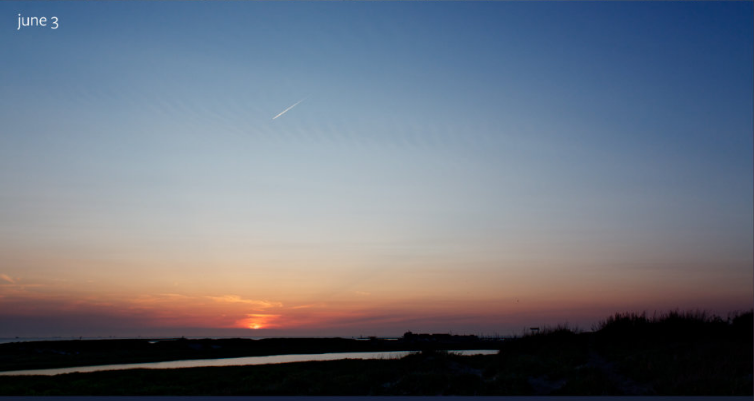
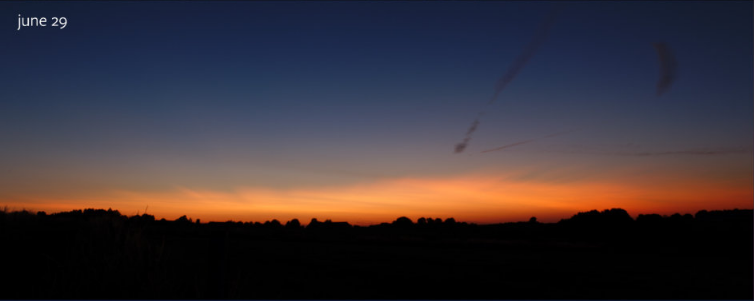
The jagged 'clouds' are possibly stratospheric.
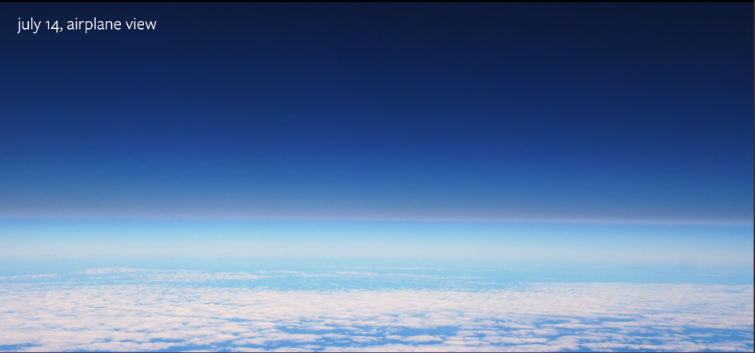
Earth's atmosphere from 10-12km high over the Atlantic. The reddened dust layer shows above the troposphere.
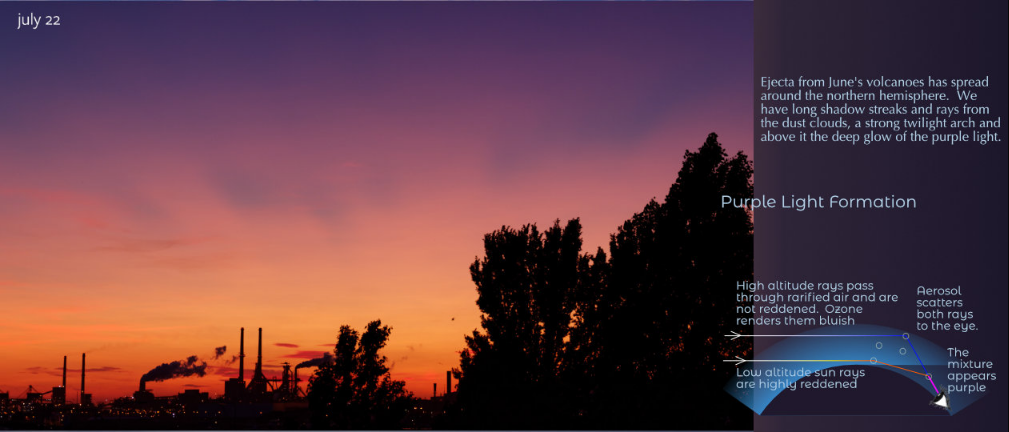
Ejecta from June's volcanoes has spread around the northern hemisphere. We have long shadow streaks and rays from the dust clouds, a strong twilight arch and above it the deep glow of the purple light.
Purple Light Formation
High altitude rays pass through rarified air and are not reddened. Ozone renders them bluish
Aerosol scatters both rays to the eye.
The Low altitude sun rays are highly reddened Mixture Appears purple

Look for finely structured straky clouds during volcanic sunset. Use binoculars and take care to distinguish them from lower ones.

Raikoke sends dust and sulfur dioxide high into the stratosphere.
The gaseous SO2 subsequently reacts with water vapour to form -1 micron
diameter aerosol droplets of sulfuric and sulfurous acids. These scatter sunlight more effectively than the dust.
ISS image courtesy of NASA.

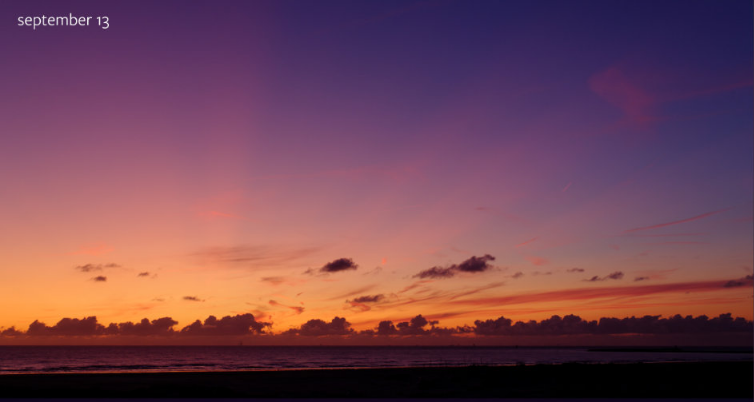
Well into September the volcano eruptions stil colour the twilight.
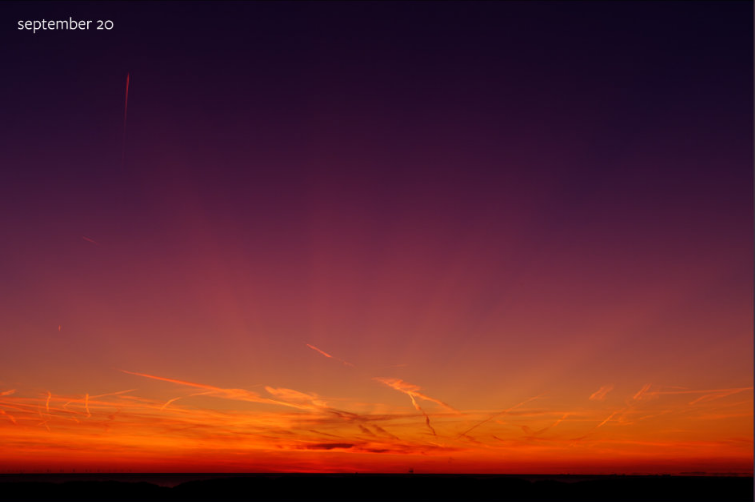

Note: this article has been automatically converted from the old site and may not appear as intended. You can find the original article here.
Reference Atmospheric Optics
If you use any of the definitions, information, or data presented on Atmospheric Optics, please copy the link or reference below to properly credit us as the reference source. Thank you!
-
<a href="https://atoptics.co.uk/blog/volcanic-twilight-diary/">Volcanic Twilight Diary </a>
-
"Volcanic Twilight Diary ". Atmospheric Optics. Accessed on December 22, 2024. https://atoptics.co.uk/blog/volcanic-twilight-diary/.
-
"Volcanic Twilight Diary ". Atmospheric Optics, https://atoptics.co.uk/blog/volcanic-twilight-diary/. Accessed 22 December, 2024
-
Volcanic Twilight Diary . Atmospheric Optics. Retrieved from https://atoptics.co.uk/blog/volcanic-twilight-diary/.